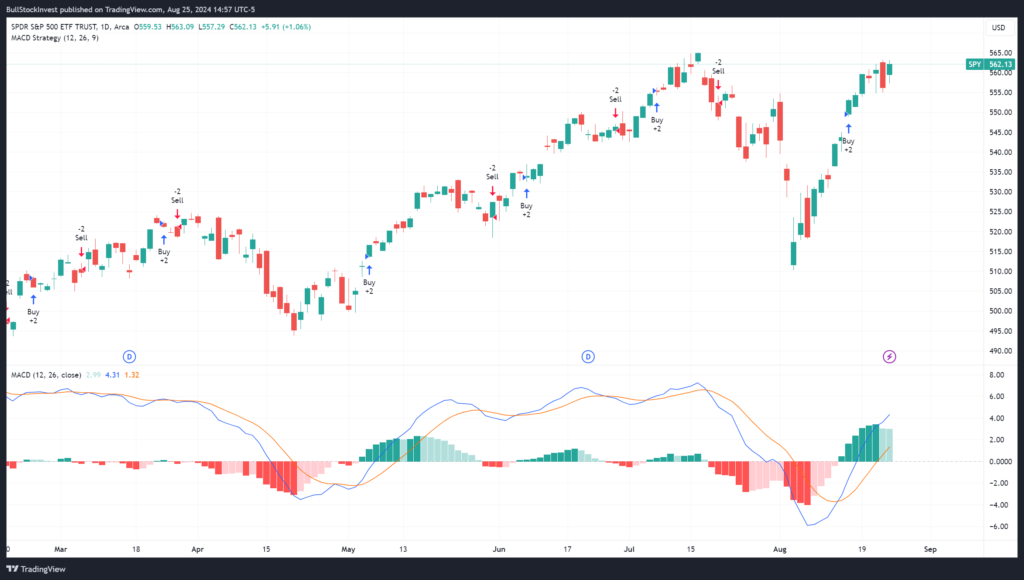The Moving Average Convergence Divergence (MACD) indicator is a popular momentum and trend-following tool used in technical analysis. It helps traders identify changes in the strength, direction, momentum, and duration of a trend in a stock’s price. The MACD is particularly useful for detecting potential buy and sell signals and is widely used in both short-term and long-term trading strategies.

Formula
The MACD Level is calculated by subtracting the 26-period Exponential Moving Average (EMA) from the 12-period EMA:

A 9-period EMA of the MACD line, known as the “Signal Line,” is then plotted on top of the MACD to act as a trigger for buy and sell signals.

Market Type: Range Bound vs. Trending
The MACD Indicator performs differently in various market conditions. In a trending market, the MACD is effective in identifying the strength and direction of the trend. However, in a range-bound market, the MACD can generate false signals due to the lack of a clear trend. Traders should be cautious when using the MACD in sideways markets and may need to adjust their strategy accordingly.
Overbought
An overbought condition occurs when the MACD Indicator Level rises significantly above the Signal Line, indicating that the asset may be overvalued and a reversal could be imminent. However, this does not necessarily mean a price drop is certain; it only signals that the price may have moved too far too fast.
Oversold
Conversely, an oversold condition is indicated when the MACD Indicator falls significantly below the Signal Line. This suggests that the asset may be undervalued and could be due for a rebound. Like the overbought condition, this is a warning rather than a definite sign of an impending price increase.
Entry
A typical entry point using the MACD occurs when the MACD Indicator line crosses above the Signal Line, signaling a potential upward trend. Traders often use this signal to initiate long positions, especially when supported by other indicators or chart patterns.
Exit
An exit signal is generated when the MACD line crosses below the Signal Line, indicating a potential downward trend. Traders may close their positions to protect profits or avoid losses, depending on their trading strategy.
Divergence
Divergence occurs when the price of an asset and the MACD indicator move in opposite directions. Bullish divergence happens when the price makes a lower low, but the MACD forms a higher low, indicating potential upward momentum. Bearish divergence occurs when the price makes a higher high, but the MACD forms a lower high, suggesting weakening momentum and a possible downward reversal.
MACD Indicator Backtesting
Backtesting the MACD indicator on different time frames, such as 1-minute and 1-day charts, helps traders understand its effectiveness in various trading scenarios. For short-term trading, a setting of 8, 17, and 9 periods might be used, while the default setting of 12, 26, and 9 is common for daily charts. Backtesting allows traders to refine their strategies and adjust the MACD settings to suit their trading style and market conditions.
| Time Interval | 1 minute | 1 day |
| Indicator Settings | Fast Length: 12 Slow Length: 26 MACD Length: 9 Source: Close Price | Fast Length: 12 Slow Length: 26 MACD Length: 9 Source: Close Price |
| Percent Profitable | 33.69% | 44.28% |
| Profit Factor | 0.96 | 1.52 |
| Sharpe Ratio | −14.83 | −285.468 |
| Sortino Ratio | −0.998 | −1 |
The MACD Indicator is a versatile and valuable tool in technical analysis, helping traders identify potential entry and exit points while providing insights into market trends and reversals. By combining MACD Indicator with other technical indicators, traders can enhance their strategies and improve their decision-making processes.




